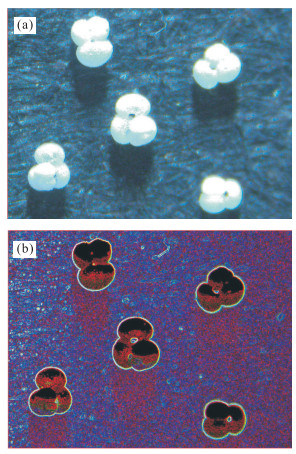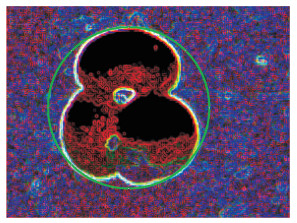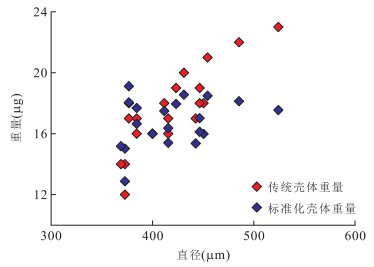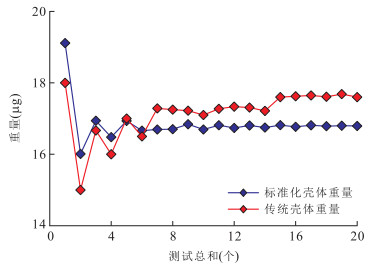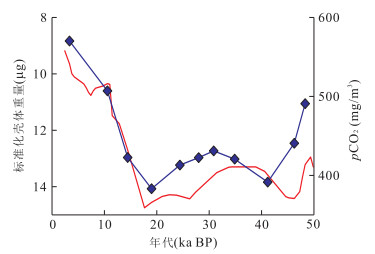Application of Planktonic Foraminifera Size-Normalized Shell Weight in the Western Pacific
-
摘要: 使用标准化壳体重量法和传统壳体重量法分别对中国南海(South China Sea,简称SCS)站表层沉积物和MD06-3052岩心沉积物样品进行了测试,获得了浮游有孔虫种属Globigerinoides ruber(G. ruber)的标准化壳体重量和传统壳体重量.通过对SCS站表层沉积物中G. ruber标准化壳体重量与传统壳体重量的比较,认为在该海域使用标准化壳体重量替代性指标能够更好的排除壳体粒径的干扰.通过对MD06-3052岩心中G. ruber标准化壳体重量与南极Vostok冰心的CO2浓度(pCO2)曲线进行对比,认为标准化壳体重量方法能够较好的反映出表层海水[CO32-]的变化.标准化壳体重量方法快速简便,指示性好,在探讨晚更新世以来表层海水在全球碳循环的重要作用中,是一个很有潜力的指标.Abstract: Planktonic foraminifera Globigerinoides ruber (G. ruber) shell weight of sediment samples from South China Sea (SCS) located in the South China Sea and MD06-3052 located in the western Pacific are tested using size-normalized shell weight method and traditional shell weight method. In comparison with traditional shell weight method, SCS data indicate that the size-normalized shell weight method for G. ruber can significantly reduce the influence of test size on foraminifera shell weight in the study area. Comparing the variation curves of CO2 concentration (pCO2) recorded in Vostok ice core, MD06-3052 G. ruber data show that size-normalized shell weight can indicate the change of sea surface water [CO32-] more effectively. The size-normalized shell weight method provides a reliable and rapid proxy for the weight analyses in the paleoceanographic study, and a potential proxy in studying the influence of surface sea water in global carbon cycle since Late Pleistocene.
-
表 1 MD06-3052岩心浮游有孔虫G. ruber标准化壳体重量及传统壳体重量
Table 1. Size-normalized shell weight and traditional shell weight of planktonic foraminifera G. ruber from MD06-3052
样品号 样品层位(cm) 年代(ka BP) 壳体数量(个) 传统壳体重量(μg) 标准化壳体重量(μg) 1 54~56 3.34 6 7.83 8.84 2 182~184 10.58 11 8.45 10.60 3 238~240 14.45 6 12.50 12.97 4 278~280 19.00 13 14.85 14.07 5 342~344 24.41 11 13.00 13.23 6 390~392 28.00 9 12.89 12.97 7 430~432 30.86 6 12.33 12.73 8 486~488 34.87 11 12.64 13.02 9 574~576 41.17 11 13.64 13.84 10 646~648 46.25 11 11.27 12.46 11 678~680 48.32 8 10.00 11.06 -
Abràmoff, M.D., Magalhães, P.J., Ram, S.J., 2004. Image Processing with Image. J. Biophotonics International, 11(7): 36-42. Aldridge, D., Beer, C.J., Purdie, D.A., 2012. Calcification in the Planktonic Foraminifera Globigerina bulloides Linked to Phosphate Concentrations in Surface Waters of the North Atlantic Ocean. Biogeosciences, 9(5): 1725-1739. doi: 10.5194/bg-9-1725-2012 Anderson, D.M., Archer, D., 2002. Glacial-Interglacial Stability of Ocean pH Inferred from Foraminifer Dissolution Rates. Nature, 416(6876): 70-73. doi: 10.1038/416070a Barker, S., Elderfield, H., 2002. Foraminiferal Calcification Response to Glacial-Interglacial Changes in Atmospheric CO2. Science, 297(5582): 833-836. doi: 10.1126/science.1072815 Beer, C.J., Schiebel, R., Wilson, P.A., 2010. Technical Note: On Methodologies for Determining the Size-Normalised Weight of Planktic Foraminifera. Biogeosciences, 7(7): 2193-2198. doi: 10.5194/bg-7-2193-2010 Bijma, J., Hönisch, B., Zeebe, R.E., 2002. Impact of the Ocean Carbonate Chemistry on Living Foraminiferal Shell Weight: Comment on "Carbonate Ion Concentration in Glacial-Age Deep Waters of the Caribbean Sea" by W.S. Broecker and E. Clark. Geochemistry, Geophysics, Geosystems, 3(11): 1064. doi: 10.1029/2002GC000388 Bijma, J., Spero, H.J., Lea, D.W., 1999. Reassessing Foraminiferal Stable Isotope Geochemistry: Impact of the Oceanic Carbonate System (Experimental Results). In: Fischer, G., Wefer, G., eds., Use of Proxies in Paleoceanography: Examples from the South Atlantic. Springer, Berlin, 489-512. Broecker, W.S., Clark, E., 2001a. Glacial-to-Holocene Redistribution of Carbonate Ion in the Deep Sea. Science, 294(5549): 2152-2155. doi: 10.1126/science.1064171 Broecker, W.S., Clark, E., 2001b. An Evaluation of Lohmann's Foraminifera Weight Dissolution Index. Paleoceanography, 16(5): 531-534. doi: 10.1029/2000PA000600 Broecker, W.S., Clark, E., 2004. Shell Weights from the South Atlantic. Geochemistry, Geophysics, Geosystems, 5(3): Q03003. doi: 10.1029/2003GC000625 Chen, R.H., Meng, Y., Li, B.H., et al., 1999. Variations in the Lysocline of Carbonate in the Southern Okinawa Trough during the Last 20000 Years. Marine Geology & Quaternary Geology, 19(1): 25-30(in Chinese with English abstract). http://d.wanfangdata.com.cn/periodical/hydzydsjdz199901004 Cooley, S.R., Kite-Powell, H.L., Doney, S.C., 2009. Ocean Acidification's Potential to Alter Global Marine Ecosystem Services. Oceanography, 22(4): 172-181. doi: 10.5670/oceanog.2009.106 Davis, C.V., Badger, M.P.S., Bown, P.R., et al., 2013. Calcification Response to Climate Change in the Pliocene. Biogeosciences Discussions, 10(4): 6839-6860. doi: 10.5194/bgd-10-6839-2013 de Moel, H., Ganssen, G.M., Peeter, F.J.C., et al., 2009. Planktic Foraminiferal Shell Thinning in the Arabian Sea due to Anthropogenic Ocean Acidification. Biogeosciences, 6(9): 1917-1925. doi: 10.5194/bg-6-1917-2009 Doney, S.C., Fabry, V.J., Feely, R.A., et al., 2009. Ocean Acidification: The Other CO2 Problem. Annu. Rev. Mar. Sci. , 1: 169-192. doi: 10.1146/annurev.marine.010908.163834 Fabry, V.J., Seibel, B.A., Feely, R.A., et al., 2008. Impacts of Ocean Acidification on Marine Fauna and Ecosystem Processes. ICES Journal of Marine Science, 65(3): 414-432. doi: 10.1093/icesjms/fsn048 Fehrenbacher, J., Martin, P., 2011. Western Equatorial Pacific Deep Water Carbonate Chemistry during the Last Glacial Maximum and Deglaciation: Using Planktic Foraminiferal Mg/Ca to Reconstruct Sea Surface Temperature and Seafloor Dissolution. Paleoceanography, 26(2): PA2225. doi: 10.1029/2010PA002035 Hönisch, B., Ridgwell, A., Schmidt, D.N., et al., 2012. The Geological Record of Ocean Acidification. Science, 335(6072): 1058-1063. doi: 10.1126/science.1208277 Hodell, D.A., Charles, C.D., Sierro, F.J., 2001. Late Pleistocene Evolution of the Ocean's Carbonate System. Earth and Planetary Science Letters, 192(2): 109-124. doi: 10.1016/S0012-821X(01)00430-7 Hull, P.M., Norris, R.D., Bralower, T.J., et al., 2011. A Role for Chance in Marine Rcovery from the End-Cretaceous Extinction. Nature Geoscience, 4(12): 856-860. doi: 10.1038/NGEO1302 Logan, C.A., 2010. A Review of Ocean Acidification and America's Response. Bioscience, 60(10): 819-828. doi: 10.1525/bio.2010.60.10.8 Lohmann, G.P., 1995. A Model for Variation in the Chemistry of Planktonic Foraminifera due to Secondary Calcification and Selective Dissolution. Paleoceanography, 10(3): 445-457. doi: 10.1029/95PA00059 Lombard, F., da Rocha, R.E., Bijma, J., et al., 2010. Effect of Carbonate Ion Concentration and Irradiance on Calcification in Planktonic Foraminifera. Biogeosciences, 7(1): 247-255. doi: 10.5194/bg-7-247-2010 Marchitto, T.M., Curry, W.B., Oppo, D.W., 2000. Zinc Concentrations in Benthic Foraminifera Reflect Seawater Chemistry. Paleoceanography, 15(3): 299-306. doi: 10.1029/1999PA000420 Marchitto, T.M., Lynch-Stieglitz, J., Hemming, S.R., 2005. Deep Pacific CaCO3 Compensation and Glacial-Interglacial Atmospheric CO2. Earth and Planetary Science Letters, 231(3-4): 317-336. doi: 10.1016/j.epsl.2004.12.024 Marshall, B.J., Thunell, R.C., Henehan, M.J., et al., 2013. Planktonic Foraminiferal Area Density as a Proxy for Carbonate Ion Concentration: A Calibration Study Using the Cariaco Basin Ocean Time Series. Paleoceanography, 28(2): 363-376. doi: 10.1002/palo.20034 Mekik, F., Raterink, L., 2008. Effects of Surface Ocean Conditions on Deep-Sea Calcite Dissolution Proxies in the Tropical Pacific. Paleoceanography, 23(1): PA1216. doi: 10.1029/2007PA001433 Mekik, F.A., Anderson, R.F., Loubere, P., et al., 2012. The Mystery of the Missing Deglacial Carbonate Preservation Maximum. Quaternary Science Reviews, 39: 60-72. doi: 10.1016/j.quascirev.2012.01.024 Moy, A.D., Howard, W.R., Bray, S.G., et al., 2009. Reduced Calcification in Modern Southern Ocean Planktonic Foraminifera. Nature Geoscience, 2(4): 276-280. doi: 10.1038/NGEO460 Naik, S.S., Naidu, P.D., 2007. Calcite Dissolution along a Transect in the Western Tropical Indian Ocean: A Multiproxy Approach. Geochemistry, Geophysics, Geosystems, 8(8): Q08009. doi: 10.1029/2007GC001615 Naik, S.S., Naidu, P.D., Govil, P., et al., 2010. Relationship between Weights of Planktonic Foraminifer Shell and Surface Water CO32- Concentration during the Holocene and Last Glacial Period. Marine Geology, 275(1-4): 278-282. doi: 10.1016/j.margeo.2010.05.004 Orr, J.C., Fabry, V.J., Aumont, O., et al., 2005. Anthropogenic Ocean Acidification over the Twenty-First Century and Its Impact on Calcifying Organisms. Nature, 437(7059): 681-686. doi: 10.1038/nature04095 Palmer, M.R., Pearson, P.N., 2003. A 23 000-Year Record of Surface Water pH and pCO2 in the Western Equatorial Pacific Ocean. Science, 300(5618): 480-482. doi: 10.1126/science.1080796 Petit, J.R., Jouzel, J., Raynaud, D., et al., 1999. Climate and Atmospheric History of the Past 420 000 Years from the Vostok Ice Core, Antarctica. Nature, 399(6735): 429-436. doi: 10.1038/20859 Qiu, X.H., Li, T.G., Chang, F.M., et al., 2012. Turbidite Deposition Record and Its Mechanism since 150 ka BP in Western Philippine Sea. Marine Geology & Quaternary Geology, 32(4): 157-163(in Chinese with English abstract). http://en.cnki.com.cn/Article_en/CJFDTOTAL-HYDZ201204026.htm Regenberg, M., Schröder, J.F., Jonas, A.S., et al., 2013. Weight Loss and Elimination of Planktonic Foraminiferal Tests in a Dissolution Experiment. Journal of Foraminiferal Research, 43(4): 406-414. doi: 10.2113/gsjfr.43.4.406 Russell, A.D., Hönisch, B., Spero, H.J., et al., 2004. Effects of Seawater Carbonate Ion Concentration and Temperature on Shell U, Mg, and Sr in Cultured Planktonic Foraminifera. Geochimica et Cosmochimica Acta, 68(21): 4347-4361. doi: 10.1016/j.gca.2004.03.013 Spero, H.J., Bijma, J., Lea, D.W., et al., 1997. Effect of Seawater Carbonate Concentration on Foraminiferal Carbon and Oxygen Isotopes. Nature, 390(6659): 497-500. doi: 10.1038/37333 Solomon, S., Qin, D.H., Manning, M., et al., 2007. Climate Change 2007: The Physical Science Basis: Working Group I Contribution to the Fourth Assessment Report of the IPCC. Cambridge University Press, New York. Wang, P.X., Min, Q.B., Bian, Y.H., et al., 1986. Planktonic Foraminifera in the Continental Slope of the Northern South China Sea during the Last 130 000 Years and Their Paleo-Oceanographic Implications. Acta Geologica Sinica, 60(3): 215-225(in Chinese with English abstract). doi: 10.1111/j.1755-6724.1986.mp60003001.x/abstract Xu, J., Huang, B.Q., Chen, R.H., et al., 2001. Distribution of Foraminifera in Surface Sediments of Northeastern South China Sea and Its Environmental Implications. Journal of Tropical Oceanography, 20(4): 6-13(in Chinese with English abstract). http://europepmc.org/abstract/cba/354100 Zeebe, R.E., 2012. History of Seawater Carbonate Chemistry, Atmospheric CO2, and Ocean Acidification. Annual Review of Earth and Planetary Sciences, 40: 141-165. doi: 10.1146/annurev-earth-042711-105521 Zhang, L.L., Chen, M.H., Chen, Z., et al., 2010. Distribution of Calcium Carbonate and Its Controlling Factors in Surface Sediments of the South China Sea. Earth Science—Journal of China University of Geosciences, 35(6): 891-898(in Chinese with English abstract). doi: 10.3799/dqkx.2010.104 陈荣华, 孟翊, 李保华, 等, 1999. 冲绳海槽南部两万年来碳酸盐溶跃面的变迁. 海洋地质与第四纪地质, 19(1): 25-30. https://www.cnki.com.cn/Article/CJFDTOTAL-HYDZ901.003.htm 仇晓华, 李铁刚, 常凤鸣, 等, 2012. 西菲律宾海15万年以来的浊流沉积及其成因. 海洋地质与第四纪地质, 32(4): 157-163. https://www.cnki.com.cn/Article/CJFDTOTAL-HYDZ201204026.htm 汪品先, 闵秋宝, 卞云华, 等, 1986.130 000年来南海北部陆坡的浮游有孔虫及其古海洋学意义. 地质学报, 60(3): 215-225. https://www.cnki.com.cn/Article/CJFDTOTAL-DZXE198603000.htm 徐建, 黄宝琦, 陈荣华, 等, 2001. 南海东北部表层沉积中有孔虫的分布及其环境意义. 热带海洋学报, 20(4): 6-13. https://www.cnki.com.cn/Article/CJFDTOTAL-RDHY200104001.htm 张兰兰, 陈木宏, 陈忠, 等, 2010. 南海表层沉积物中的碳酸钙含量分布及其影响因素. 地球科学——中国地质大学学报, 35(6): 891-898. https://www.cnki.com.cn/Article/CJFDTOTAL-DQKX201006002.htm -









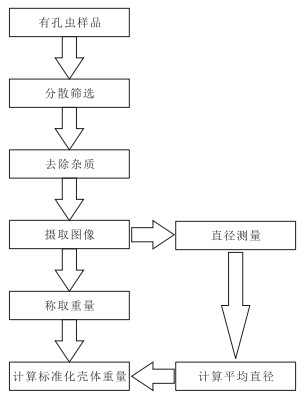
 下载:
下载:
